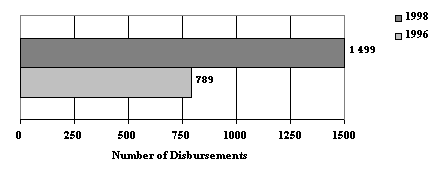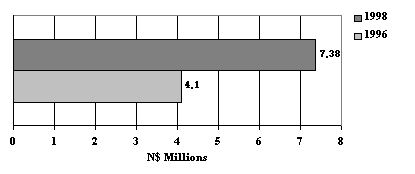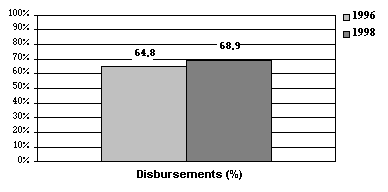

![[DIGITALE BIBLIOTHEK DER FES]](/images/digbib/d_digbib.gif)

TEILDOKUMENT:
SECTION 5:
A Brief Comparison of Trends in Credit Provision to SMEs in Namibia in 1996 and 1998
This section of the booklet is devoted to comparing the findings of the present study with those of the aforementioned study on the same subject conducted in 1996. The availability of these parallel sets of research data represents a unique opportunity for those seeking to gain a wider perspective of Namibia’s SME sector.
To generate the clear and structured perspective sought through this comparative exercise, a methodology was devised which entailed determining what information was logically necessary, and then dividing the selected pieces of information into four main groups of indicators, as follows:
- General – total size of fund; number of loans; training; collateral.
- Strategic – gender; new/ongoing; urban/rural; industry.
- Effectiveness – total capital disbursed; average loan size; default rate.
- Efficiency – processing capacity; staff; disbursement period.
The 1996 questionnaire responses and the individual data collected in 1996 together form the data set to be compared with the updated 1998 data set. It should be noted that the NGO and parastatal credit providers are accounted for in this exercise as a single or combined domain base. Whether NGO or parastatal, seven of the eleven credit providers interviewed in 1996 were interviewed again in 1998, which helps to ensure the fairness and reliability of the conclusions of this exercise.
5.1 GENERAL INDICATORS
Indicators for the general situation of the credit delivery system to SMEs in the two periods under review suggest that the total funds available for disbursement by the credit providers surveyed increased from N$4,1 million in 1996 to over N$7,38 million in 1998. [ The increase has occurred either in individual terms as an NGO or parastatal or as groups of NGOs or parastatals. Moreover we may take into consideration the fact that the OHA did not provide information on this specific issue and the PSF loans portfolio is excluded. It has also been noted that parastatal loan funds have also been delivered to medium-sized enterprises.] The total number of loans disbursed by these credit providers also increased, from 789 in 1996 to 1 499 in 1998. It is also important to note the growing number of institutions which envisage providing services such as training as part of their schemes.
FIGURE 1: TOTAL FUNDS COMPARISON
FIGURE 2: TOTAL NUMBER OF LOANS DISBURSED [ The graph on total funds presents data collected for the NGO group only because the NDF was not included in the 1996 study and the massive financial input of this parastatal would have affected the data analysis. However, the data presented on the total number of loans disbursed is inclusive of all the credit providers surveyed.]

It is also important to note that a growing number of credit providers foresee the requirement of collateral in their schemes. In 1998 only the OHA did not require any form of collateral, as compared to four institutions which did not require any in 1996.
5.2 STRATEGIC INDICATORS
This set of indicators gives us an idea of the strategic choices made by the credit providers surveyed with a view to offering better loan products and improving the operational environment for SMEs in Namibia.
In this regard, firstly, the number of loans made available to women entrepreneurs has increased substantially from around 40% to more than 60% on average, which reveals that credit providers are committed to the task of bridging the gender gap in the SME sector.
Secondly, the data reflecting the number of loans delivered to ongoing enterprises as opposed to those just starting out, and the data reflecting the urban/rural split in loans disbursement, indicate a more careful approach in that the general preference of credit providers in 1996 was to support urban rather than rural enterprises, and those which were ongoing rather than starting out, which is no longer necessarily the case.
The final strategic indicator reveals interesting information regarding the industries ideally preferred, and perhaps reflects the reasons underlying the decisions made in this regard, as well as on the research that has been undertaken towards assuring more sustainable operations.
FIGURE 3: PERCENTAGE OF LOANS DISBURSED BY SECTOR [ The retail figure is around 3%. ]
These indicators essentially refer to the achievements or output of the enterprises served as measured against their own goals or stated objectives. In other words, this indicator is concerned with the consequences of the effort of credit providers rather than the effort itself.
The first indicator here refers to the total capital disbursed by the credit providers as loans, [ This indicator takes into account the whole loan portfolio of the DFN, which includes loans to SMEs as well as loans in amounts of above N$100 000 . (See also note 12.)] which has increased since 1996 to an amount of N$5 085 203 in 1998, pointing to an improved service to SMEs as well as an improved use of the funds.
The second indicator here refers to the average size of the loans disbursed, which has decreased since the 1996 study.
The third effectiveness indicator refers to the default rate, and here the figures seem to have remained constant from 1996 to 1998. This suggests that measures need to be devised to minimise the effect of default on the credit schemes so that they may serve SMEs better.
FIGURE 4: PERCENTAGE OF TOTAL AVAILABLE LOAN CAPITAL DISBURSED
"Efficiency" is a notion related to the productivity of an endeavour and must take into account the alternatives facing the implementers of a project for transforming the means at their disposal into real output. In other words, efficiency is to a large extent dictated by implementation procedures.
The first indicator that may enable an efficiency assessment of the credit providers surveyed is their loan processing capacity per month, as determined by the time span required to analyse a normal loan request. The 1996 responses to this question revealed that the PSF [ See Appendix: Private Sector Foundation.] processed almost half of all the loans disbursed in one month, while the other six credit providers surveyed in 1996 processed the other half. Today there is not so wide a gap between the processing capacities of the credit providers, and the average number of loans processed in a month in 1996 was only slightly higher at 116 than the 102 processed per month in 1998.
Another efficiency indicator concerns the number of people involved at all levels of a credit scheme’s implementation process. The combined number of staff assigned to implement the schemes surveyed has increased from 67 in 1996 to 73 in 1998.
The third efficiency indicator implicitly confirms the accuracy of the previous two. The period of time required to disburse a single loan in 1998, being six weeks on average, is shorter than it was in 1996 at an average of seven weeks.
This section of the booklet has principally proved that credit providers have paid attention to speeding up loan procedures.
© Friedrich Ebert Stiftung | technical support | net edition fes-library | Mai 1999


